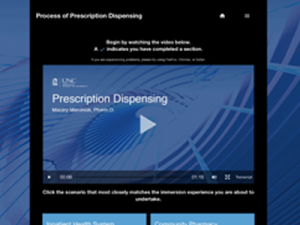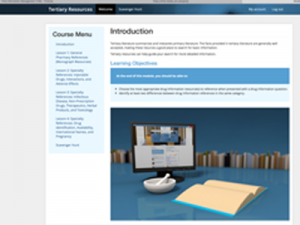Online Teaching Tools for Pharmacy
Through the years the MEDIA team has created numerous online tools for faculty members to integrate into their courses. A partial list is below. We encourage you to consider incorporating these resources into your lectures. If you’d like to use any of these tools in your teaching, or if you’re interested in custom work, please contact us (Service Now).
Will you be working with MEDIA on your next interactive project? If so, a good introduction is our one-page PDF prep tool.
Biochemistry Animations

Short animations focus on very specific topics relating to biochemistry (basis theory of catalysis, catalysts, ΔG, kinetic rate constants, interpreting logarithmic scales, and protonation). Easy to integrate into course lectures.
- Link: https://apps.media.unc.edu/biochem500/
- Access: Open access
- Andrew Lee, PharmD
Biostatistics

Primer covers basic concepts in biostatistics, including data characteristics, descriptive statistics, inferential statistics, measurement considerations, group differences, continuous outcomes/linear regression, categorical outcomes/odds ratio/risk assessment, categorical outcomes/between groups differences, and other tests. Useful as pre-work or remediation.
- Link: https://wp.media.unc.edu/biostatistics/
- Access: UNC Onyen authentication
- Dr. Jacqui McLaughlin
Carolina Acute Stroke Treatment

Nine modules provide the latest research in both adult and pediatric stroke care. Topics include anatomy and physiology, introduction to stroke, emergency management, acute ischemic stroke treatment, management of hemorrhage, stroke prevention, nursing care of the stroke patient, stroke rehabilitation, and pediatric strokes. Appropriate for registered nurses, first responders, and allied health professionals.
- Link: https://learn.pharmacy.unc.edu/strokecare
- Access: Open access
- Dr. Suzi Wilson
Carolina Nanoformulation Workshop

Workshop explores how to use nanoformulations to overcome drug delivery issues and improve the translation from bench to bedside to positively impact therapeutic outcomes.
- Link: https://virtualcnw.org
- Access: Fee-based
- Dr. Alexander Kabanov
Communicating with Young People in Pharmacy Settings

Online modules explore two communication strategies (motivational interviewing, teach-back) that pharmacists can use to facilitate conversations with all of their patients, particularly young people. Collaboration between pharmacy schools at Monash University, University College London, and the University of North Carolina-Chapel Hill.
- Link: https://apps.media.unc.edu/pharmalliance/
- Access: Open access
- Betsy Sleath, PharmD; et al.
- Published in the International Journal of Pharmacy Practice in 01 October, 2019.
Comprehensive Cancer Center

Website includes patient education animations, pharmacology lectures, and videos demonstrating effective communication techniques for doctor-patient interactions in cancer clinics.
- Link: https://chemotalk.cips.unc.edu/
- Access: UNC Onyen authentication
- Jill Bates, PharmD
Controlled Substance Reporting System

For-credit course introduces the controlled substances reporting system and uses case studies to explain how to apply it in outpatient, community, and inpatient settings.
- Link: https://apps.media.unc.edu/csrs
- Access: Open access
- Jay Campbell, PharmD
Crash Cart

Interactive tool introduces learners to the locations and uses of medications and equipment that are commonly found on emergency room crash carts. Includes a heart rhythms section that provides instruction on how to identify and treat irregular heartbeats.
- Link: https://apps.media.unc.edu/crashcart
- Access: Open access
- Greene Shepherd, PharmD
Cross-Cultural Decision Making

Website introduces learners to foundational knowledge about implicit bias, stereotype threat, and impostor syndrome.
- Link: https://ccld-dept-pharmsim.cloudapps.unc.edu/
- Access: Open access
- James Beaudoin, PharmD; Nick Klus, PharmD
Epigenetics Animation

Animation explores the role that epigenetics plays in tissue identity and the development of disease. Topics addressed include active vs. repressed chomatin, the enzymes responsible for modifying histone tails, how histone modifications influence gene expression, and how identical chemical marks on histone tails can signal two different events.
- Link: https://www.youtube.com/watch?v=WgERHur3FMQ
- Access: Open access
- Nate Hathaway, PharmD
Foundations in Pharmacokinetics (iBook)

Modules address drug disposition, absorption kinetics, dosing regimen calculations, hepatic and renal clearances, nonlinear and non-stationary kinetics, pharmacologic response, and a general mathematical review. Extensive practices and quizzes are provided.
- Link: https://itunes.apple.com/WebObjects/MZStore.woa/wa/viewCollaboration?cc=us&ids=1190686362-1190686365&mt=11
- Access: $34.99, Apple Books Store
- Also available online on request
- Adam Persky, PharmD; Gary Pollack, PharmD
High Performance Liquid Chromatography

Virtual HPLC machine orients learners to both the hardware and software associated with chromatography.
- Link: https://apps.media.unc.edu/hplc/
- Access: Open access
- Dr. Laurence Orlando
Leading Pharmacy Change

Website explores how to handle change in a pharmacy in a constructive way. Includes two modules: introducing a new service in the pharmacy and value stream mapping as a way to optimize efficiency.
- Link: https://wp.media.unc.edu/changemgmt/
- Access: Open access
- Kea Turner; Chelsea Renfroe, PharmD
Pathophysiology

Series of modules provide high-level overviews of the pathology underlying common medical conditions, including chronic heart failure, cardia arrhythmias, asthma, cystic fibrosis, inflammation, bone health, erectile dysfunction, female reproductive hormones, Parkinson’s disease, stroke syndromes, epilepsy, hemostasis, anemia, acid-base, peptic ulcer disease, GERD, pain, and pancreatic disorders.
- Link: https://shib.media.unc.edu/pathophys/
- Access: UNC Onyen authentication
- Dr. Carol Otey, et al.
PharmLabs

First (and only) nationally and internationally open-source website for compounding science. Recognized as Basic Resource in Pharmacy by AACP since 1999.
- Link: https://pharmlabs.unc.edu
- Access: Open access
- Robert Shrewsbury, PhD
Process of Prescription Dispensing

Website provides an overview of the prescription dispensing process in both community and hospital settings.
- Link: https://shib.media.unc.edu/dispensing
- Access: UNC Onyen authentication
- Macary Marciniak, PharmD
Self-Care Learning Module

Website focuses on the QuEST method of assessing a patient’s self-care needs. Includes information about medical conditions frequently encountered in a pharmacy setting, including allergic rhinitis, constipation, contact dermatitis, and heartburn.
- Link: https://shib.media.unc.edu/selfcare
- Access: UNC Onyen authentication
- Stefanie Ferreri, PharmD
Shared Decision Making

Online module introduces shared decision making as a useful tool when considering options for medical treatment, particularly for young people. Includes instruction about opioid alternatives when treating pain in pediatric patients.
- Link: https://wp.media.unc.edu/sdm
- Access: Open access
- Delesha Carpenter, PhD, MSPH; et al.
Team-Based Care

Interactive module presents a model of patient care that includes increased communication and collaboration between healthcare providers. Learners are presented a scenario in which various health care providers cooperate to provide comprehensive services to an individual patient.
- Link: https://apps.media.unc.edu/cpf/
- Access: Open access
- Chelsea Renfro, PharmD
Tertiary Resources

Online module introduces basic concepts about tertiary literature, including general pharmacy references and specialty references for injectable drugs, infectious disease, non-prescription drugs, herbal products, and toxicology, among other topics.
- Link: https://tertiaryresources.sites.unc.edu
- Access: Open access
- Dr. Gang Fang
Virtual Pharmacopedia

Short modules provide clinically relevant information about common conditions and conveys content through a variety of media, including text, illustrations, interactive diagrams, audio files, and animations. Current modules include veterinary diabetes mellitus, Hodgkin lymphoma, necrotizing fasciitis, and ventricular arrhythmias.
- Link: https://virtualpharmacopedia.wp.cips.unc.edu/
- Access: UNC Onyen authentication
- Student-developed content
-
- Keepteaching.unc.edu
- Resources for maintaining course continuity during temporary closures
- Source: UNC-CH Center for Faculty Excellence
- Moving to Alternative Instructional Formats 3-23-20
- Bare essentials for teaching online quickly and efficiently (PDF)
- Source: NC Digital Learning Initiative
- QM Emergency Remote Instruction Checklist
- Tiered list of considerations, tips, and actionable strategies (Google Doc)
- Source: QualityMatters
- Tips and Tools for Teaching Online in a Pinch
- Crowdsourced Google doc
- Source: Crowd-sourced
- Remote Teaching Resources for Business Continuity
- List of links to other institution COVID teaching plans/ guides (Google doc)
- Source: Crowd sourced
- What Katrina Taught Us About Online Delivery
- Lessons learned during emergency online delivery of classes after Hurricane Katrina in 2005
- Source: EduCause
- Teaching Online Resources
- Crowd-sourced list of links for best practices for online teaching and learning, including synchronous/ asynchronous courses, assessments, collaboration, virtual labs, accessibility, student learning (Google doc)
- Source: Online Learning Consortium (OLC)
- Teaching Effectively During Times of Disruption
- Suggestions for instructors looking to continue offering a student-centered learning experience in a remote or online learning environment (Google doc)
- Source: Stanford University
- Remember Accessibility in the Rush to Online
- 10 tips to ensure everyone has access to same course content
- Source: National Deaf Center
- Continuity of Learning During Emergencies
- Guidelines for maintaining learning envrionment while remaining FERPA and HIPAA compliant
- Source: UNC-CH School of Medicine
- Now that students are remote, are you ready to help them succeed?
- Simple things instructors can do to make sure students most in need of help get it
- Source: EAB
- Please do a bad job of putting your courses online
- Tips for teaching online during COVID-19 crisis
- Source Rebecca Barrett-Fox
- Strategies for Structuring Teaching from Home: Planning Your Way to an Effective Day
- Suggestions on how to maximize the perks and minimize the pitfalls of teleworking
- Source: UNC
- Videoconferencing Alternatives: How Low-Bandwidth Teaching Will Save Us All
- Alternatives to video lectures to make courses more flexible and accessible
- Source: DePaul University’s IDDblog
- Teaching Online in a Pinch (Self-paced module)
- Free, 4-hour module for online teaching. Great tips about recording video on your own – look at “Asynchronous (Self-paced) Teaching Approaches” and click on “Record Videos”.
- Source: Bryant University
- Keepteaching.unc.edu
